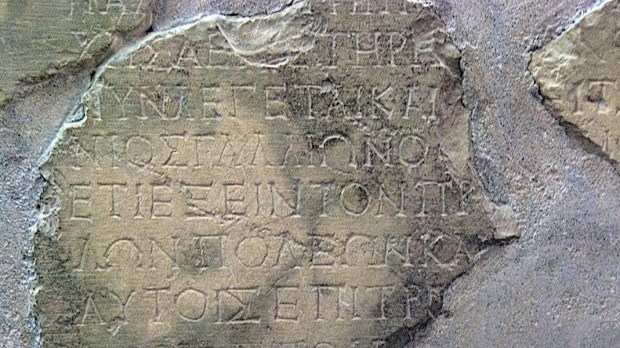An ancient inscription discovered in 1905 helped clarify St. Paul’s journey of evangelization and sheds light on early Church history.
It all has to do with one of Paul’s trials, and how a Roman official handled it.
Chapter 18 of the Acts of the Apostles tells us:
… when Gallio was proconsul of Achaia, the Jews rose up together against Paul and brought him to the tribunal, saying, “This man is inducing people to worship God contrary to the law.” When Paul was about to reply, Gallio spoke to the Jews, “If it were a matter of some crime or malicious fraud, I should with reason hear the complaint of you Jews; but since it is a question of arguments over doctrine and titles and your own law, see to it yourselves. I do not wish to be a judge of such matters.” And he drove them away from the tribunal. They all seized Sosthenes, the synagogue official, and beat him in full view of the tribunal. But none of this was of concern to Gallio.
The Gallio referred to was Lucius Junius Gallio Annaeanus. Born Lucius Annaeus Novatus around 5 B.C. in Córdoba, Spain, he changed his name when he was adopted by the Roman senator Junius Gallio. His father was Seneca the Elder and his brother was the philosopher, Seneca the Younger, who became the tutor of the future Emperor Nero.
Seneca the Younger attests to him in his Naturales Quaestiones:
One began by paying homage to his intellect, the greatest and worthiest of all, which one had rather see consecrated to the service of heaven than wasted in weak human effort; he ran away from one who talked thus. Or one began to praise his thrift he was so indifferent to money that he seemed neither to possess it nor to condemn it he cut short the very first words of the panegyric.
In addition, the poet Statius described him as being “honey-tongued.” In A.D. 51, Gallio was chosen to serve as the proconsul of Achaea in Greece.
According to Bryan Windle, a staff researcher and writer for the Associates for Biblical Research (biblearchaeology.org), a group of scholars and archaeologists who are dedicated to demonstrating the historical reliability of the Bible through archaeological and biblical research, a key to understanding how Gallio helps shed light on early Christian history is an archaeological artifact known as the Delphi Inscription, sometimes called the Gallio Inscription.
“In 1905, a French excavation team at Delphi, Greece, unearthed a group of four fragments inscribed with a Greek inscription. Over the next few years, five more fragments were uncovered which turned out to be a copy of a letter from the Emperor Claudius to the city, addressing the problem of their sparse population. The inscription was likely attached at one time to the walls of the Temple of Apollo in Delphi. It has been reconstructed to read”:
“Tiberius Claudius Caesar Augustus Germanicus, 12th year of tribunician power, acclaimed emperor for the 26th time, father of the country, sends greetings to [… ]. For long have I been well-disposed to the city of Delphi and solicitous for its prosperity, and I have always observed the cult of the Pythian Apollo. Now since it is said to be destitute of citizens, as my friend and proconsul L. Iunius Gallio recently reported to me, and desiring that Delphi should regain its former splendour, I command you (singular) to invite well-born people also from other cities to come to Delphi as new inhabitants, and to accord them and their children all the privileges of the Delphians as being citizens on like and equal terms. For if some are transferred as colonists to these regions….”
The inscription confirms that Gallio was the proconsul of Achaia, as Luke recorded in the book of Acts, wrote Windle, who is also pastor of Island Bible Chapel in Northern Ontario, Canada. He explains that at that time Achaia was a Roman senatorial province, which included the cities of Athens, Corinth, and Delphi.
In addition, the inscription “helps us pinpoint the date of Paul’s stay in Corinth,” Windle said. “The inscription states that Claudius had been ‘acclaimed emperor for the 26th time,’ dating it to between January and August, A.D. 52. In his book on biblical chronology, Dr. Andrew Steinmann notes that, since Proconsuls usually took office on May 1st and served for only one year, we know that Gallio served as Proconsul of Achaia from the second half of A.D. 51 to the first half of A.D. 52. The Gallio Inscription is a fixed marker by which we can date most of Paul’s ministry and much of the history of the early Church.”
Windle sums up: “Luke is a historian who claims to have carefully investigated everything and to have consulted with eyewitnesses (Luke 1:1-4). In the case of the judgment of Gallio, he likely heard this account directly from the Apostle Paul himself, with whom he traveled. The details in the biblical account align with what is known about Gallio from sources outside of the Bible and have been affirmed by archaeological findings.”

